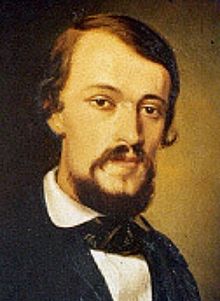Theodor Bilharz | |
|---|---|
 | |
| Born | 23 March 1825 Sigmaringen, Germany |
| Died | 9 May 1862 (aged 37) Cairo, Egypt |
| Resting place | Old Cairo 30°01′N 31°14′E / 30.017°N 31.233°E |
| Citizenship | German |
| Alma mater | University of Tübingen |
| Known for | Discovery of bilharzia and Schistosoma haematobium |
| Scientific career | |
| Fields | Medicine; Parasitology |
| Institutions | University of Freiburg Qasr El Eyni Hospital |
| Author abbrev. (zoology) | Bilharz |
Theodor Maximilian Bilharz (23 March 1825 – 9 May 1862) was a German physician who made pioneering discoveries in the field of parasitology. His contributions led to the foundation of tropical medicine.[1] He is best remembered as the discoverer of the blood fluke Schistosoma haematobium, the causative parasite of bloody urine (haematuria) known since ancient times in Egypt. The parasite, as the cause of bladder cancer, is declared by the International Agency for Research on Cancer as Group 1 carcinogen. The infection is known by an eponymous term bilharzia or bilharziasis, as well as by schistosomiasis.
Bilharz was born and educated in Sigmaringen, Hohenzollern-Sigmaringen, Germany. After graduating in natural science and philosophy from the Albert-Ludwigs-Universität in 1845, he earned a medical degree from the University of Tübingen in 1849. In 1850, he followed his former teacher Wilhelm Griesinger to Egypt to work at the Qasr El Eyni Hospital in Cairo. He became the first autopsy performer there. From autopsies of children, he observed a variety of helminth parasites and discovered the tapeworm Hymenolepis nana and the flatworm Heterophyes heterophyes in 1851. Early in that year he found a male worm from a dead soldier. As a novel worm with two mouth-like suckers, he named it Distomum haematobium, the description of which was published by his mentor Karl Theodor Ernst von Siebold in 1852. He further discovered that it was the eggs and not the flukes that caused the disease. He also unknowingly discovered another related blood fluke, later identified as Schistosoma mansoni, the most prevalent human helminth.[2]
While he was professor of anatomy at the Qasr El Eyni Medical School (now part of the University of Cairo), he contracted typhoid fever or typhus at Massawa during an expedition organised by Ernest II, Duke of Saxe-Coburg and Gotha. He died of it at age 37. The United Arab Republic established Theodor Bilharz Research Institute in his honour in 1962.
- ^ Schadewaldt, H. (1962). "Theodor BILHARZ (1825-1862), one of the founders of German tropical medicine research". Munchener Medizinische Wochenschrift. 104: 1730–1734. ISSN 0027-2973. PMID 13976588.
- ^ Chitsulo, L.; Engels, D.; Montresor, A.; Savioli, L. (2000). "The global status of schistosomiasis and its control". Acta Tropica. 77 (1): 41–51. doi:10.1016/s0001-706x(00)00122-4. PMC 5633072. PMID 10996119.